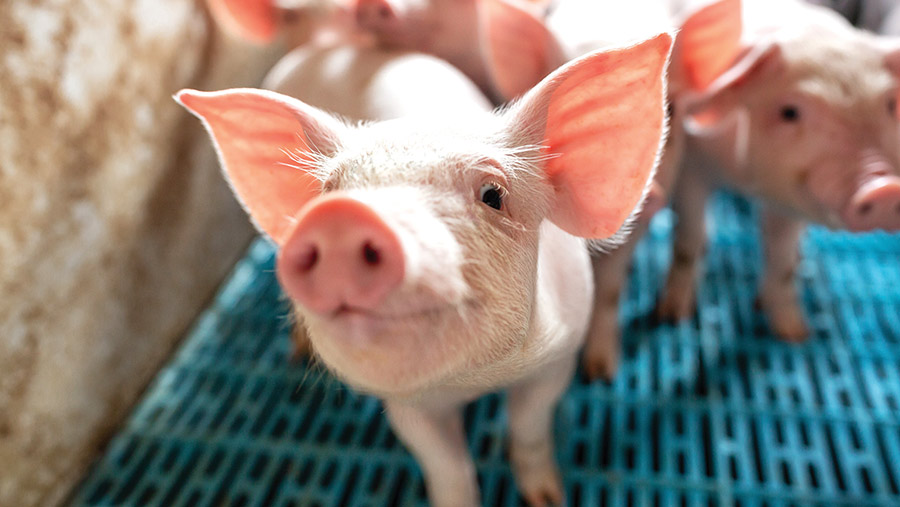‘Whole system feed efficiency’ could help pig profits
 © Didesign/Adobe Stock
© Didesign/Adobe Stock Pig farmers should avoid viewing feed efficiency as simply feed conversion ratio and consider how it is affected by health, mortality, and wider inefficiencies through the whole production chain.
By evaluating the creation of kilos of pork protein relative to total inputs in the production chain – whole system feed efficiency – the pig industry can make big strides forward, according to Dr Julia Adriana Calderon Diaz, Pig Improvement Company’s (PIC) genetic services specialist.
She told delegates at the recent Alltech One Conference, Dublin (19-20 June), that the pig industry was too focused on the genetic component of feed efficiency (FE), in the conversion of feed inputs into pigmeat.
See also: Feed and slurry key to pig producers’ emissions reduction
Julia said FE was highly heritable (30-40%), but management was critical to realise the genetic potential of animals and maximise output from a given level of input.
“It is time to change the way we think about feed efficiency in the pork industry,” she said.
“We can breed the best pig for all sorts of traits – prolificacy, growth, robustness, carcass – but if it is mismanaged, it’s a waste of time. You would not drive a Ferrari like you drive a Toyota.”
She explained that genetic gains were worthwhile. A 0.1 increase in FE from 2.3kg to 2.2kg would save €4.18 (£3.59) a pig, or €117.45 (£100.83) a sow a year (based on 28.1 pigs a sow a year), according to PIC calculations.
Although genetic improvement is “cumulative and permanent”, farmers and pig breeders should look at robustness, farrowing house performance and every production stage to reduce waste and improve profit.
Julia outlined some key management areas affecting overall farm feed efficiency, including late mortality.
The cost and inefficiency of a pig dying at 100kg is enormous, she said.
If a pig is weaned at 7kg, and reaches 100kg with a feed conversion rate of 2.3, the wasted feed amounts to 213.9kg, and the nutrients excreted into the environment total roughly:
- 8kg of nitrogen
- 5kg of phosphate
- 5kg of potassium.
Efficiency factors
The pig used labour hours, took up a space on the farm, and resulted in zero output.
Julia explained one study that costed the impact of a case of porcine reproductive and respiratory syndrome virus (PRRSv) (see table below) at nearly £5 a pig.
This showed the importance of progress in PRRSv vaccinations and developing genetic resistance.
Costs associated with PRRSv |
|||
|
Metric |
PRRS positive |
PRRS negative |
Savings |
|
Feed use |
241.3kg |
229.2kg |
12.1kg saved 329.1kg a sow a year |
|
Feed cost |
£65.99 |
£62.66 |
£3.33 a pig saved or £93.57 a sow a year |
|
Net profit |
£11.97 |
£16.84 |
£4.87 saved or £136.84 a sow a year |
|
Source: Frontiers in Veterinary Epidemiology and Economics. Based on 28.1 pigs a sow a year |
|||
Balanced improvement
To make sustainable progress in genetic improvement, Julia said the PIC strategy was to improve the following four areas in breeding programme herds to get more pigs reaching slaughter with less wastage, thus lifting whole farm FE:
- Sow herd productivity More viable piglets of optimum birthweight with greater litter uniformity and efficient sows means more meat a sow a litter with reduced labour.
- Fast and efficient growth Good terminal sire genetics, high weaning weights, heavy carcass weights and good performance at heavy weights mean a return on investment from good nutrition and smaller carbon footprint.
- Robust genetics This helps sow longevity and lowers piglet mortality, resulting in limited antibiotics use, improved animal welfare and reduced labouring.
- Total carcass value Maximising primal values and eating quality reduces waste, improves nutrition, and helps affordability for the consumer.
Ensuring progress on all four fronts meant there were more pigs reaching slaughter and less wastage.
Genetic gains reported at PIC over the past 10 years included:
- A gain of 0.1% in pig survivability each year
- A reduction in piglets born under 0.9kg from 15% to 6% since 2013
- Pigs reaching 118kg of liveweight 18 days sooner.

